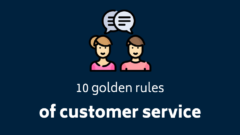Brand extension is all about making loyalty of your customer base work for you in a slightly different field. There is a high probability that your clients will feel comfortable enough to buy something new from the company they trust. But keep in mind that trust has its limits. Brand extension might be a very risky venture if done carelessly. Here are some tips on how to do it safely and what kind of mistakes you should avoid to maintain equity of your brand.
Let’s dig into the most important do’s of extending your brand:
1. Choose the right product to fit your current niche. The logical association is the key. You need to make sure that your average customer won’t flinch with disbelief while discovering new products on your website. Look for a product that would convey similar values.
2. Ask yourself: is there a demand for my new product? That’s what you should always do when venturing into the new field. But in case of brand extension, you need to consider the demand of your loyal customer base more than the overall demand in the market. The most important thing is to not waste the trust that you gained and to maintain the core values of your brand.
3. Estimate costs and potential profits. That one is pretty obvious. Brand extension will, as any new business venture, create the need for additional spendings, especially for marketing. Consider if you have enough capital and manpower before starting up because you really can’t afford to do it wrong. The credibility of your existing brand is at stake here.
4. Find your unique selling point. The product you’d like to introduce is probably already sold in countless places. Unless it’s a complete innovation, you need to find out what would set you apart from the competition. The power of your brand will help you with positioning the new product, but you should also find the way to attract new clients.
5. Sub-branding, brand extension or maybe a new standalone brand? Consider your options and choose the best fit. Brand extension is simple – you introduce new product under the same name, and market it to your loyal customers with hope to gain more of them. The sub-brand is a similar idea, but you give your new product a bit more independence. Sub-brands often have different logos, packaging and website layout, with some elements connecting them to the parent brand. They are directed at a slightly different customer base, but the prestige of the parent brand still plays a key role. The standalone brand, on the other hand, is a completely independent entity in the eyes of your clients. That’s the least risky way to introduce something new, but requires a lot of work, since you need to build awareness of the new brand from scratch.
So, with the basic do’s of brand extension covered, we can move on to don’ts:
1. Diluting your brand. Too many products that are not easily associated with one another under one ‘family name’ may cause confusion amongst your clients. Accidental diluting can lead to devaluing your brand and this mistake is extremely hard to fix.
2. Stretching too far. You need to estimate the flexibility of your brand to stretch it without the risk of hitting the breaking point. How to do it? Consider the core values of your brand. If you can’t make your new product convey the similar message about your values, then it probably isn’t the right product for you to invest.
3. Creating a negative association with the mother brand. Be careful not to harm your already well-established brand. For example, if you have an online tech hardware store, then products like utility software, video games, ebooks or movies would probably go well along with your current brand. But imagine introducing cheap low-end mobile phones to your website. That would be associated with computers and TVs logically, but not quite positively.
4. Neglecting one of the products financially or in the marketing field. It might be tempting to go full steam ahead with the new idea, but don’t lose track of what happens to the previous ones. No matter how well any of your products are doing, you need to take proper care of all of them. Remember that the reputation of your company is at stake.
Brands, if exposed to any marketing mistake, lose their appeal, often irreversibly. But the prospects of attracting new customers, conquering unfamiliar markets, and increasing profits are tempting. If you are confident that you can pull this off, then go ahead and make your brand extension happen. But when there is a large degree of uncertainty, endangering your well-established brand might be just not worth it. In that case, you should consider launching a completely new standalone brand that is powered by your company but not associated with it at first glance.
In both instances, CodesWholesale has a lot to offer. Base your new business venture on exploiting the leverage that your brand already has or use your company structures to make something entirely new. You can connect your existing online store to CodesWholesale or launch a completely new one easily. Either way, the opportunity for growth is within your reach.
Profit from CodesWholesale’s reputation
Whatever strategy and product range you settle for, always consider its influence on your company’s reputation. After a seamless integration with CodesWholesale, you can import thousands of ready-to-sell products with all the essential assets. With us, you can sell keys from renowned distributors, publishers, and developers without the usual hassle with negotiating stock and prices. Let CodesWholesale’s reputation fuel your business!
About the author

- Elliot
- Content specialist and gaming enthusiast. Trained to be a philosopher. Interested in Deep Learning, scalability and startups.






